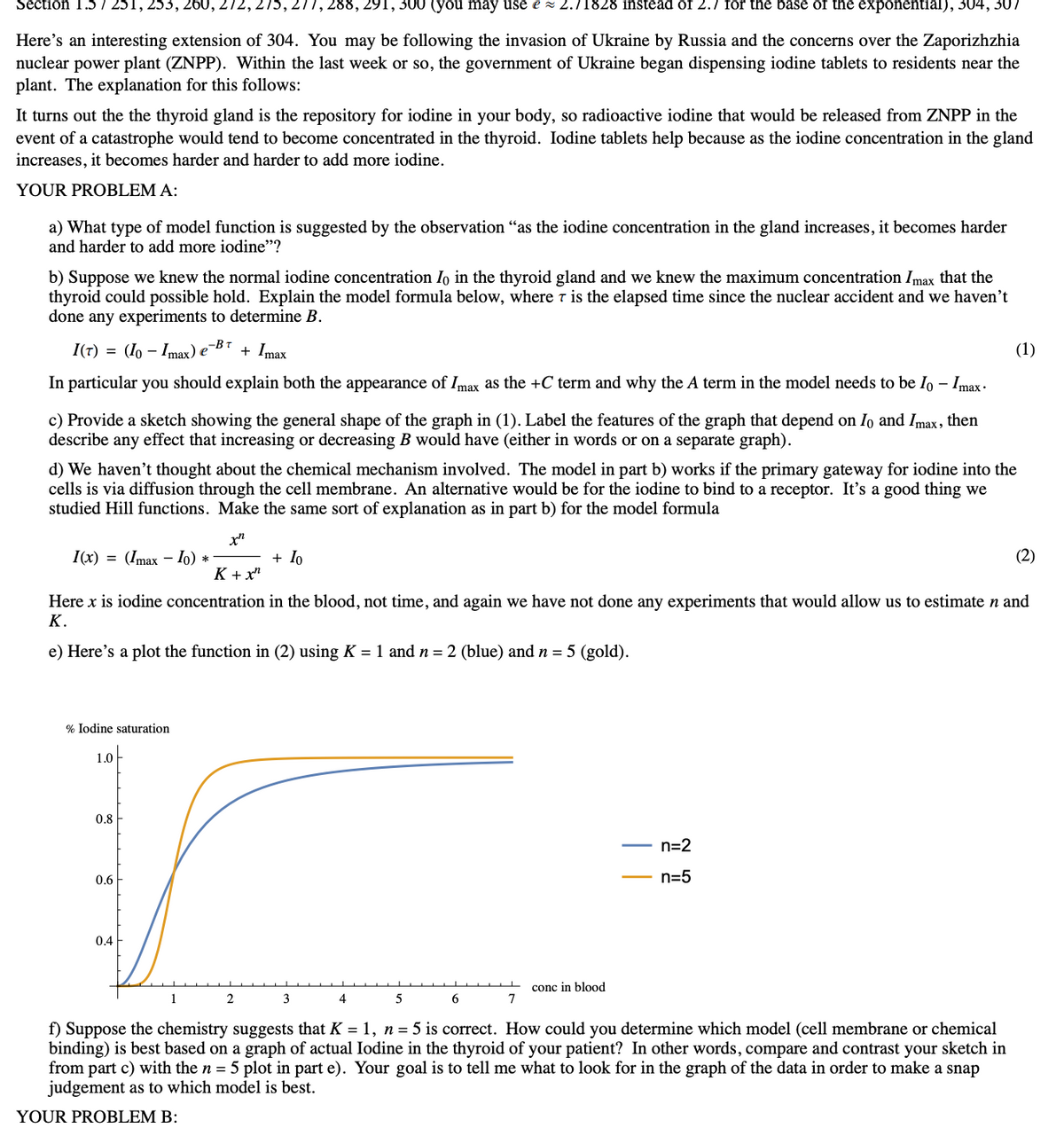a) What type of model function is suggested by the observation "as the iodine concentration in the gland increases, it becomes harder and harder to add more iodine"? b) Suppose we knew the normal iodine concentration Io in the thyroid gland and we knew the maximum concentration Imax that the thyroid could possible hold. Explain the model formula below, where 7 is the elapsed time since the nuclear accident and we haven't done any experiments to determine B. I(T) = (lo - Imax) e-BT + Imax In particular you should explain both the appearance of Imax as the +C term and why the A term in the model needs to be lo - Imax.
a) What type of model function is suggested by the observation "as the iodine concentration in the gland increases, it becomes harder and harder to add more iodine"? b) Suppose we knew the normal iodine concentration Io in the thyroid gland and we knew the maximum concentration Imax that the thyroid could possible hold. Explain the model formula below, where 7 is the elapsed time since the nuclear accident and we haven't done any experiments to determine B. I(T) = (lo - Imax) e-BT + Imax In particular you should explain both the appearance of Imax as the +C term and why the A term in the model needs to be lo - Imax.
Algebra & Trigonometry with Analytic Geometry
13th Edition
ISBN:9781133382119
Author:Swokowski
Publisher:Swokowski
Chapter5: Inverse, Exponential, And Logarithmic Functions
Section: Chapter Questions
Problem 78RE
Related questions
Question
Hi please do not reject this question even if you can only do and b that would be so helpful thank you!!

Transcribed Image Text:Section 1.57251, 253, 260, 272, 275, 2 288, 291, 300 (you may use e ≈ 2.71828 instead of 2.7 for the base of the exponential), 304, 307
Here's an interesting extension of 304. You may be following the invasion of Ukraine by Russia and the concerns over the Zaporizhzhia
nuclear power plant (ZNPP). Within the last week or so, the government of Ukraine began dispensing iodine tablets to residents near the
plant. The explanation for this follows:
It turns out the the thyroid gland is the repository for iodine in your body, so radioactive iodine that would be released from ZNPP in the
event of a catastrophe would tend to become concentrated in the thyroid. Iodine tablets help because as the iodine concentration in the gland
increases, it becomes harder and harder to add more iodine.
YOUR PROBLEM A:
a) What type of model function is suggested by the observation "as the iodine concentration in the gland increases, it becomes harder
and harder to add more iodine"?
b) Suppose we knew the normal iodine concentration Io in the thyroid gland and we knew the maximum concentration Imax that the
thyroid could possible hold. Explain the model formula below, where is the elapsed time since the nuclear accident and we haven't
done any experiments to determine B.
- Imax) e-BT + Imax
In particular you should explain both the appearance of Imax as the +C term and why the A term in the model needs to be Io - Imax.
I(T)
=
c) Provide a sketch showing the general shape of the graph in (1). Label the features of the graph that depend on Io and Imax, then
describe any effect that increasing or decreasing B would have (either in words or on a separate graph).
I(x)
d) We haven't thought about the chemical mechanism involved. The model in part b) works if the primary gateway for iodine into the
cells is via diffusion through the cell membrane. An alternative would be for the iodine to bind to a receptor. It's a good thing we
studied Hill functions. Make the same sort of explanation as in part b) for the model formula
xn
K+xn
Here x is iodine concentration in the blood, not time, and again we have not done any experiments that would allow us to estimate n and
K.
e) Here's a plot the function in (2) using K = 1 and n = 2 (blue) and n = 5 (gold).
=
1.0
(10
% Iodine saturation
0.8
0.6
0.4
(Imax - 10)
1
2
+ Io
3
4
5
6
7
conc in blood
n=2
n=5
(1)
f) Suppose the chemistry suggests that K = 1, n = 5 is correct. How could you determine which model (cell membrane or chemical
binding) is best based on a graph of actual Iodine in the thyroid of your patient? In other words, compare and contrast your sketch in
from part c) with the n = 5 plot in part e). Your goal is to tell me what to look for in the graph of the data in order to make a snap
judgement as to which model is best.
YOUR PROBLEM B:
(2)
Expert Solution
This question has been solved!
Explore an expertly crafted, step-by-step solution for a thorough understanding of key concepts.
This is a popular solution!
Trending now
This is a popular solution!
Step by step
Solved in 3 steps with 2 images

Recommended textbooks for you

Algebra & Trigonometry with Analytic Geometry
Algebra
ISBN:
9781133382119
Author:
Swokowski
Publisher:
Cengage


Glencoe Algebra 1, Student Edition, 9780079039897…
Algebra
ISBN:
9780079039897
Author:
Carter
Publisher:
McGraw Hill

Algebra & Trigonometry with Analytic Geometry
Algebra
ISBN:
9781133382119
Author:
Swokowski
Publisher:
Cengage


Glencoe Algebra 1, Student Edition, 9780079039897…
Algebra
ISBN:
9780079039897
Author:
Carter
Publisher:
McGraw Hill

Algebra for College Students
Algebra
ISBN:
9781285195780
Author:
Jerome E. Kaufmann, Karen L. Schwitters
Publisher:
Cengage Learning

Trigonometry (MindTap Course List)
Trigonometry
ISBN:
9781337278461
Author:
Ron Larson
Publisher:
Cengage Learning
